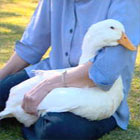Breed: Pekin, Saxony, Indian Runner ducks
Temperament: Pekin and Saxony: friendly, placid. Indian Runner: excitable, timid
Cost: from $20
Lifespan: 7-10 years
Maintenance: medium
Recommended for: hobbyists, fenced gardens
Appearance
The Pekin is an attractive, large white duck. The plumage may show a tinge of cream or yellow. They weigh 3.5-4kg (about 8-9lb) with yellow or reddish-orange bill and legs. They are usually bred for meat but are equally useful in the backyard. And if you think the Pekin looks familiar, you’ve probably seen one on TV. The Walt Disney animated character Donald Duck was based on a Pekin duck.
The Saxony is a stylish bird, weighing about 3-4kg (7-9lb). Drakes (boys) are rusty red with silver lacing, while the head and neck are blue with a white neck ring. Ducks (girls) are buff-coloured on the head, neck and breast with a white eye-line. Wing bars and tail are light blue. Both have a yellow bill, dark brown eyes and dark yellow feet.
Indian Runners are comparatively light; about 1.6-2.25kg (3.5-5lb) for drakes and 1.35-2 kg (3-4.5lb) for ducks. Drakes are 65-80cm (26-32 in.), ducks 60-70 cm (24-28 in.). Does this one look familiar too? Well, you may remember Ferdinand from the movie ‘Babe’.
The Indian Runner doesn’t waddle. The position of its legs gives it a distinctive running motion. Described as being like ‘a wine bottle’ this duck has a long, snake-like neck.
Uses and space
Ducks are useful for all sorts of purposes; as snail eaters, egg layers, for meat or simply as a hobby. It’s just a matter of choosing a breed that suits your backyard and needs.
Most duck breeds are well suited to suburban backyards, although some such as the Muscovy can be a little more difficult to handle. All ducks can be messy and may trash a vegetable garden if allowed. Pools or ponds aren’t essential, however a water container large enough to allow them to dunk is essential to ensure their eyes, nostrils and beaks stay clean and healthy.
Ducks do best when they have plenty of space in which to wander and so are best suited to larger backyards. It’s important to check with your local council to ensure by-laws allow the keeping of poultry or waterfowl in the area. Although it is uncommon for by-laws to exist in relation to a few backyard birds, most councils have regulations pertaining to noise and pollution created by animals. Pekins tend to be the most noisy of these three.
Temperament
The Saxony and Pekin are calm, placid ducks, not flighty or aggressive towards children. The Saxony has a very good temperament and is very easy to handle. This is the best backyard duck of the three.
Indian Runners can be aloof and excitable. Show-bred Indian Runners are more easily handled than backyard bred specimens.
Breeding
Pekins are not considered good sitters although they do produce up to 120 eggs per season.
Saxony ducks are said to be fairly good sitters but most hobbyists will use incubators. If allowed to sit naturally 50 or more ducklings per pair may be produced annually.
Although Indian Runners are prolific egg-layers, they are not very broody. Therefore, if you wish to breed them, and you don’t have access to an incubator, the eggs should be placed under another broody duck to hatch. Indian Runners, unlike some other duck breeds, do not need water for breeding (although they must have water available at all times for drinking). Ducklings are best raised in small flocks.
Feeding
Commercial duck pellets are available from produce stores and are available in a range of mixes: starter, grower and breeder pellets. Ducks also eat vegetables but may not readily accept scraps such as peelings or hard vegetables. Most won’t eat more than 125 grams per day. A 40kg bag of duck pellets should last an adult pair at least one month. Duck feed should be placed in bowls to prevent contamination. Water bowls should be accessible at all times and should be anchored with bricks to prevent the ducks turning them over.
Health and lifespan
Ducks rarely suffer from ill health when well looked after and protected from predators.
Dry bedding is important to avoid foot infections such as bumble foot. Diarrhoea may indicate worms or coxyliosis. Vets will diagnose and treat both conditions but if ignored, can be fatal. Worm regularly, about twice a year.
The feeding requirements of poultry and waterfowl can attract rodents. Place rat baits in lengths of piping where the rats can get in but the ducks can’t.
Maintenance and cost
Ducks need a predator-proof shed or shelter to keep them safe at night and provide protection from the weather. Dry straw or a similar bedding is also necessary. Renew the bedding every couple of days.
Pekins range from $70-$100 per bird, Saxonys $30-$70 and Indian Runners from about $20 – $50.
Ideal owner
These three types of duck can be successfully kept by poultry enthusiasts of all ages and ability. They are best suited to people who have a yard area available and can offer the ducks a penned or caged area.
A single duck can be lonely. It’s advised to keep at least two for companionship. A common turn-off is the mess which ducks make. Owners suggest hosing off any faeces of an evening into the lawn. Duck poo makes for excellent fertiliser.
Further information
We filmed this segment with Jacqueline Cupitt of the Hawkesbury Valley Waterfowl Club of New South Wales. For further information contact Jacqueline Cupitt on (02) 4577 6830.
SA
South Australian Waterfowl Club Inc.
Ian Siegele
Phone: (08) 8379 9409
VIC
Victorian Waterfowl Association
Bret Henderson
Phone: 0400 074 048
QLD
Waterfowl Association of Queensland
Steven Armstrong
Phone: 0417 641 759
WA
Waterfowl Association of WA
Stuart Hearn
Phone: (08) 9390 2542
NSW
NSW Waterfowl Association
Doug Sommerville
Phone: (02) 4828 6619



